If the VHP’s shilanyas in 1989 marked the beginning of the fall of the Congress, the Ram Mandir Bhumi Poojan ceremony stamps the emergence of the new politics brought in by the BJP.
From November 9, 1989, when the Vishva Hindu Parishad (VHP) conducted a shilanyas here, to Wednesday, August 5, when Prime Minister Narendra Modi will lay a 40-kg silver brick to begin the construction of the Ram temple, Ayodhya has witnessed a medley of historical, cultural, religious and political events.
VHP’s Shilanyas:
Exactly three decades before, on the same day the Supreme Court approved the construction of the Ram Temple at the disputed site, on November 9, 1989, the VHP had put the first stone for the Ram Mandir in Ayodhya.
At a time when then-Prime Minister Rajiv Gandhi, who had stormed to power with a brute majority in the Lok Sabha, was on a slippery wicket – due to his mishandling of Sri Lanka and the Kashmir situation as well as the intensifying attack against him by the Opposition on the Bofors scandal – the VHP was charged at the ground over the cause of Ram Mandir.
Ever since it had announced a foundation laying ceremony at Ayodhya, Hindus from across the world started sending it financial assistance for the cause. The VHP was all set, but the Lucknow bench of Allahabad High Court ordered a status quo.
Determined to defy the court order, VHP collected funds and bricks with Shree Ram written on them, organised kar sevaks and held prayers to go ahead with the Shilanyas.
Rajiv Gandhi’s government, apparently hoping to cash in on Hindu sentiments to tide over the intensifying political agitation and public anger against his government, decided to let the VHP conduct the ceremony. Then-Home Minister Buta Singh, who met VHP leader Ashok Singhal, granted him permission to go ahead.
Later, as the fervour and communal tension escalated, the Centre and the state governments tried to get the VHP leaders to agree on conducting the Shilanyas outside the disputed site.
But on November 9, a congregation of VHP leaders, including Sadhus, dug a 7x7x7 ft pit to lay the singhdwar (main entrance) of the sanctum sanctorium, clearly on the disputed land, defying the agreement they had made with the authorities.
L K Advani’s Rath Yatra
The most important milestone in the BJP’s political journey. The BJP had campaigned heavily over the Ram Temple on the disputed site issue ahead of the 1989 elections, in which it won 89 seats, a giant leap from its tally of two in the previous Lok Sabha polls.
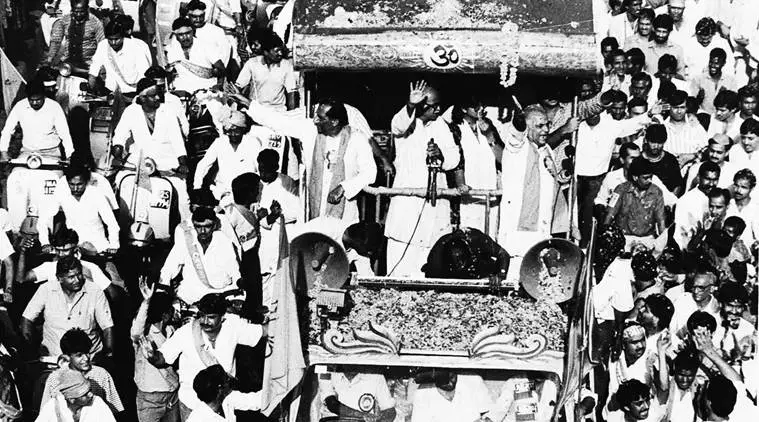 Advani’s rath yatra was the most important milestone in the BJP’s political journey. (Express Archive)
Advani’s rath yatra was the most important milestone in the BJP’s political journey. (Express Archive)
Sensing the political opportunity the Ram Temple could create – Lord Ram is the most revered and a uniting figure for Hindus, who follow different rituals and practices across the country – Advani, in September 1990, decided to go for a yatra to educate people about the Ram Janmabhoomi movement, which had so far been propagated by the VHP mainly.
Advani’s Toyota-turned-chariot procession from Somnath, Gujarat, to Ayodhya via central India stirred Hindu sentiments and mobilised the community behind him. Advani almost attained the image of a saint and a savior. It led to the events in December 1992.
Babri Masjid demolition on December 6, 1992
Frenzied karsevaks, inspired by the calls of the BJP and VHP leaders, clambered up the domes of the 16th century Babri Masjid and pulled it down, again breaking the assurances given to the Centre and the state governments. The communal violence this sparked across the country left almost 2,000 people dead.
President’s Rule was imposed in several states, dismissing the BJKP governments in Uttar Pradesh, Madhya Pradesh, Rajasthan and Himachal Pradesh. But it embarked the BJP on a wider political path that led to its emergence as the most prominent and widespread political party in the country, replacing the decades-long dominance of the Congress.
Liberhan Commission
The justice M S Liberhan Commission of inquiry was appointed within two weeks of the demolition and was asked to submit a report within three months. The Commission availed 48 extensions and finally submitted its 10,000-page report on January 30, 2009
The legal battle is back in April 2002
The matter was back at the courts and yet another legal battle began. A three-judge Bench of the Allahabad High Court was hearing to determine the ownership of the disputed land. The HC ordered the Archaeological Survey of India (ASI) to excavate the site and determine if it was a temple earlier.
In 2003, ASI found evidence of the presence of a temple under the mosque. This re-energized the VHP, and its chief Ashok Singhal asked the then-BJP government to make a legislation to hand over the site to the Hindus so that the construction of the temple could begin.
In September 2010, the High Court, which took the ASI’s findings along with other evidence before it into consideration, ruled that the disputed land should be divided into three parts — a third should go to Ram Lalla Virajman, represented by the Akhil Bharatiya Hindu Mahasabha; one-third to the Sunni Waqf Board; and the remaining to the Nirmohi Akhara.
In December, the parties moved Supreme Court. Neither the VHP-BJP nor the Muslims was happy with the order. In May 2011, the apex court stayed the High Court order.
Meanwhile, the VHP continued its campaign with vigour. But the BJP’s coming to power and its silence over the temple as well as the RSS leaderhsip’s advice not to escalate pressure over the Ram Temple forced them to lie low.
Towards the end of 2018, the VHP again raised its pitch, with hundreds of thousands of Hindu seers and followers assembling in Ayodhya. It along with Shiv Sena organised Dharma Sabhas in different parts of the country and pressed the government to issue an ordinance for the construction of the temple. They were later backed by even the RSS leaders. BJP’s senior leaders had to hold several rounds of discussions with the RSS’ top leadership to convince them that the government had to wait for the Supreme Court verdict.
On November 9, 2019
A five-judge Supreme Court bench led by then Chief Justice of India (CJI) Ranjan Gogoi ruled in favour of Ram Lalla, and said the entire disputed land spread over 2.7 acres will be handed over to a trust formed by the government, which will monitor the construction of the Ram Temple at the site.
February 5, 2020
The Union Cabinet approved the setting up of the Trust, with the Prime Minister making the announcement in the Lok Sabha. The Trust, named Shri Ram Janmabhoomi Tirtha Kshetra, is to take decisions independently on the construction of the Ram temple and related issues. It has been handed over the whole 67.703 acres acquired “to maintain the sanctity of Ayodhya and for the construction of the temple, keeping in mind the needs of crores of devotees,” Modi said.
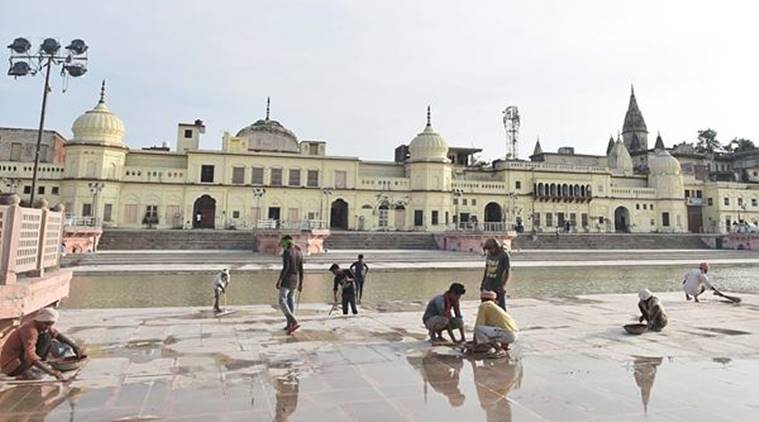 Workers clean Ram Ki Paidi in Ayodhya on Sunday, August 2. (Photo: PTI)
Workers clean Ram Ki Paidi in Ayodhya on Sunday, August 2. (Photo: PTI)
VHP leader Champat Rai, General Secretary of the Trust, announced that there would be no change to the Ram Temple from the model suggested by the VHP 30 years ago.
The prayers and the ceremony started on Tuesday morning with the worship of Lord Hanuman’s mark in Ayodhya, as he is believed to preside over the city.
The Shri Ram Janmabhoomi Tirtha Kshetra has invited 175 people, including 133 saints and seers from 36 spiritual traditions all over the country, along with RSS, VHP and BJP leaders, including the party Faizabad MP Lallu Singh for Wednesday’s event. VHP’s representatives have sent holy soil from Uttarakhand’s Char Dham shrines and water from Ganga for the Bhumi Pujan.
(Source:Express Explained- Written by Liz Mathew)

Readers like you, make ESHADOOT work possible. We need your support to deliver quality and positive news about India and Indian diaspora - and to keep it open for everyone. Your support is essential to continue our efforts. Every contribution, however big or small, is so valuable for our future.

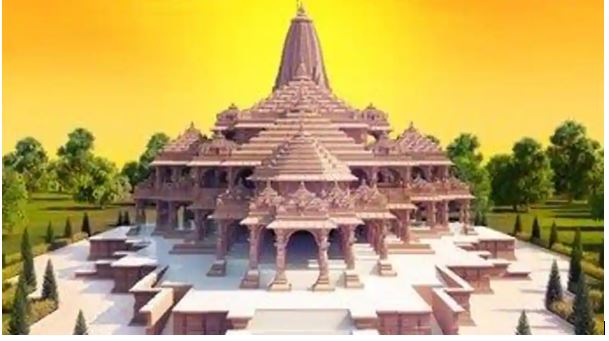
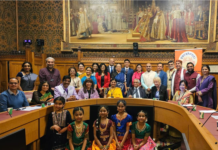

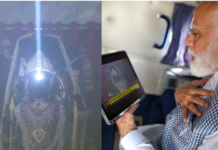

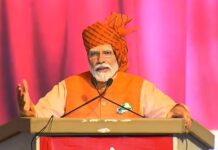
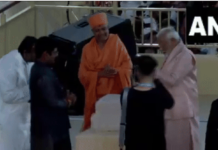




Fascinating journey from an act of defiance against treachery by the marauders to a popular cause. Bhagwan Shri Ram inspired all from different walks of life here and abroad